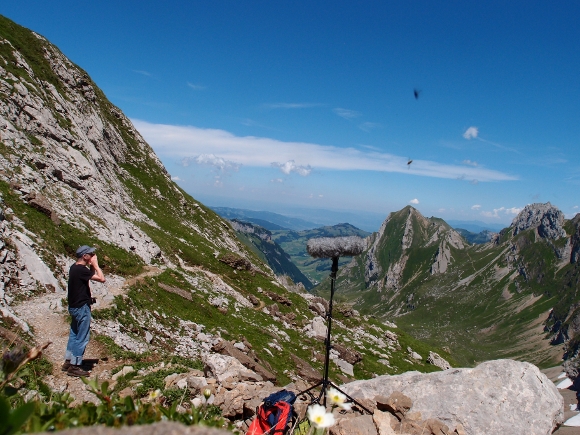|
"On the Breeze" Technique: speakers, media player, text
Klang–Moor–Schopfe September 1–10, 2017
My installation On the Breeze ended up being a kind of documentation of a work that otherwise would have never been seen or heard. I spent several weeks traveling in the Swiss canton of Appenzell Innerrhoden, much of this time in the Alpstein mountain area. I used my voice to interact with the environment, wherever I might have been and whenever I felt inspired. I would not call what I was doing singing but more a kind of vocalizing, feeling my way into the space of Appenzell with my voice. The Alpine tradition of the Alpsegen, something akin to a prayer or hymn sung by farmers and shepherds in the mountain regions of Austria, Germany, Switzerland and Norther Italy, was my primary inspiration. For the Alpsegen a farmer goes to a higher ridge or lookout – sometimes barefoot! – and, with the help of a funnel held to his mouth and thus amplifying the resonance of his voice, sings a call for blessing or prayer to the evening sun setting. I remember the first time I heard this quite by accident one evening near the small mountain settlement of Brüsti in the Swiss canton of Uri. The effect was both eerie and beautiful, with the hair standing up on my neck. My feeling was that, aside from the spiritual and religious contexts of this, the Alpsegen was also another way of the farmers connecting to the space of their world. The singer's voice rings out across the ridges and valleys, sometimes echoing back in response, sometimes disappearing into the void. This space becomes something malleable, a conjunction of physical environment and faith. A voice, that most human of sounds, calls to this space and creates a unity of sound and feeling to close another day in the mountains and – further – in life. For On the Breeze I wanted to use my voice in a similar way, probing the social, environmental and spiritual space of Appenzell. I wanted especially to move beyond the cliché of the Alpine yodel or a dry phenomenological inquiry into the acoustical properties of my voice's properties as it ricocheted from ridge to valley. For me, space is more than a physical entity. It's properties involve a conflux of thoughts and perceptions, taking into account social, political, environmental and spiritual contexts – not necessarily parameters we can objectively quantify but which nevertheless create a living unity we can perceive and move through with our thoughts, bodies and emotions. To these ends, I made recordings of my voice in the mountains and valleys of the Alpstein area; beneath train stations, in churches, in trains, town squares, cable cars, cemeteries, in front of fountains and waterfalls, on empty roads and in rolling fields. Some of the places I visited or traveled through were Wasserauen, Chobel, Seealpsee, Meglis Alp, Rotsteinpass, Lisengrat, Säntis, Brülisau, Sämtisersee, Bollenwies, Weissbad, Lehmen, Ahorn, Fählensee, Fählenalp, Altmann, Plattenbödeli, Hoher Kasten, Rainhutte, Staubern, Bötzel, Schäfler, Ohrli, Ebenalp, Schwägalp, Appenzell, Urnäsch and, last but certainly not least, Gais. Often times the incessant sound of cowbells or cows mooing were a constant (maybe too constant!) companion. But this I had to accept, along with the sounds of airplanes, jetliners and helicopters cutting through the airspace more often and conspicuously than I'd have preferred. And all the hikers and tourists! This all, along with the farmers and the barren mountain peaks and the desolate sound of someone playing accordion in a small barn well above the tree line, all contributed to this formation of space we call Appenzell. It should be emphasized, however, that I wasn't off on an some safari, roaming through the region in search of the most memorable, inspiring places. Doing this would have implied a fetishization of the space. I didn't want to create postcards so much as be in the space – any space – and find a way of interacting with it through my voice and thoughts jotted down in short texts. Even in the most mundane, seemingly unyielding places – the pedestrian underpass of a train station, sitting in a noisy train, broiling in the midday sun by a gurgling fountain in a town square in the city of Appenzell – I often found just as much inspiration as walking a dazzling trail well above the tree line. This may sound improbable or even absurd, for otherwise why would people spend so much time and money to visit far away exotic places, but one of the points of this whole journey was less about my actual presence in these individual places than my awareness of them. To be somewhere awe-inspiringly beautiful but not really take notice of that beauty through one's full awareness would be just as pointless. Strangely enough, I didn't meet with any peculiar or negative reactions to what I was doing. Often times people would start to use their voices too – not so much to test the echo of a ravine or ridge but to just feel the sound of one's own voice in this space. This meant not just hearing one's voice as it became part of the world but what it felt like in that moment to project oneself outwards across the landscape. Like with the Alpsegen we can approach a spiritual unity with the world around us through our voices. Perhaps my unwitting audience or witnesses sensed this. Or was it just the microphone mounted on a tripod, and more often than not flexing in the wind, a kind of legitimization for what I was doing? Once, when I went to get some water at a house not far from where I was working, the woman farmer asked if I was recording my voice. Apparently, this would not be such an uncommon undertaking in the mountains. I answered yes and started to excuse myself but she said it didn't bother her in the least. This is perhaps something akin to my experiences in Kyoto, where the city has been combed over by inquiring phonographers for as long as recording equipment has existed. Nobody bats an eye at people doing strange things with microphones there. Parallel to using my voice I also wrote short texts, inspired by the places and their sounds. Sometimes these texts coincided with a sound recording but more often than not they were in a sense recordings themselves, but instead of transformed to digital data on my sound recorder they were scribbled down to paper. One might ask why my voice wasn't enough. Perhaps it was but I also felt the need to record my thoughts and feelings and forays into this space in a more abstract manner, something distinct from the sound recordings I was making. The texts offer fragments of memory and perception. They have no meaning other than serving as a reflection of my place in a certain space at a certain point in time. And more than this I often just felt the urgent need to jot my thoughts and feelings down, following in my own way Jack Kerouac's dictum, First thought, best thought. Finally, though, the ultimate questions – both for myself and perhaps from others – would be, Why did he have to do any of this. Can't we just do this in everyday life, without making recordings or writing down anything or showing the results in the form of an artwork? And, of course, my answer would have to be, Yes! And please do!! Which is probably the main point: how can we transform life into something we can live with and through as opposed to something we run away or hide from? How can re re-connect with the world around us, achieve an awareness that reflects our true holistic selves? We've lost so much in the past decades with the advent of mobile media devices. It seems now the prevalent idea is that the spaces we move through each day are more something to be avoided than contemplated or at the very least taken notice of. I think everyone should take a walk in the mountains and scream at the top of their lungs! Or write a short poem if they feel so moved. Or not do anything but take a walk, have a look around, open one's ears and eyes. Take it all in, from the majestic to the banal. We can then re-connect to the world around us. This prevalent lack of awareness only adds to alienation, fear and the sense that everything around us is out of control and that we have no way of dealing with this. But the first step in re-centering our spirits, minds and bodies is in opening up to the possibilities of awareness. Nothing could be more simple yet, apparently, also more difficult. This heightened awareness thus becomes both an act of creativity and resistance. We can do better than cower behind our devices. If we are to save what's left of the world and ourselves we have to wake up to what's around us, even if it is sometimes unpleasant or just plain boring. 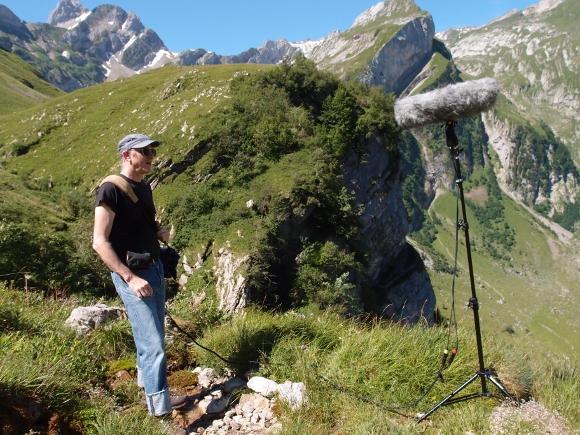
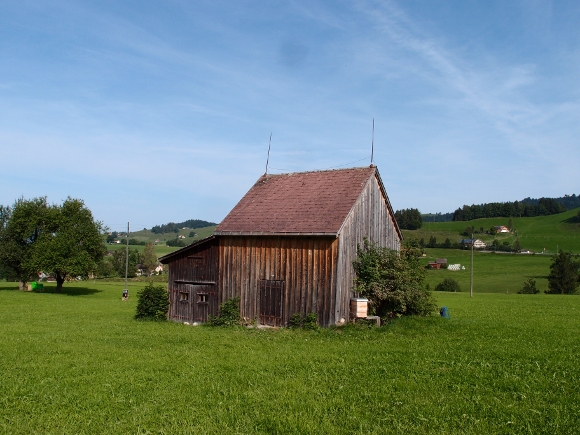
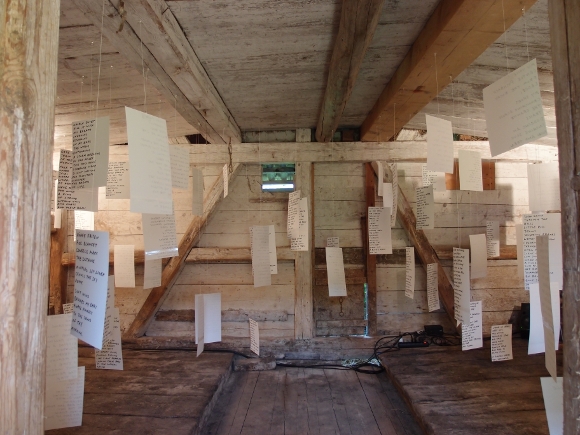
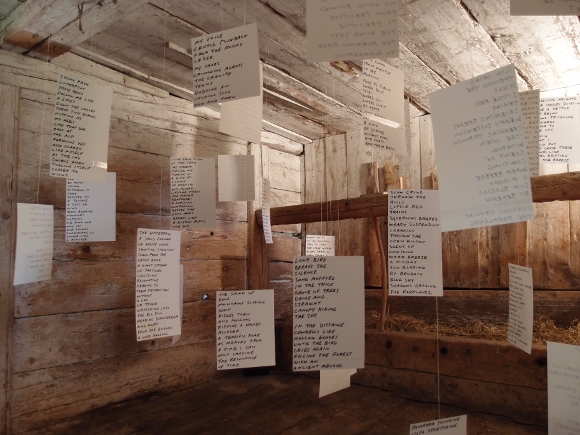
Höher Kasten fog blanket cowbells mark the distance. Muffled jet liner crawls the sky above. Soft wind brushes my ears awake finally to the sound of the morning. --------------------------
Giant rocks --------------------------
My voice --------------------------
Lookout point
hear excerpts from the installation
|
